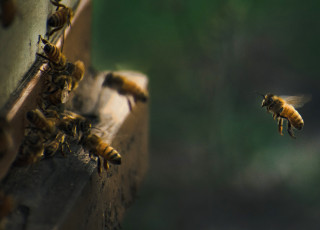Weird And Wonderful: Why Mantises Are Awesome Alien Assassins
Enjoy this article and don't forget that BugFest returns to NHMU on August 9–10, 2025! Come join us for this BIG celebration of Utah’s tiniest residents.
By Olivia Barney
Across every continent (save Antarctica), thousands of sneaky predators blend into their environments — carefully watching their surroundings for prey, waiting for the perfect moment to strike. To us, these precision killers are affectionately known as praying mantises, but to other insects, they’re alien-like assassins that keep the bug world in balance.

All mantis species belong to the order Mantodea and feature a few key characteristics that make them so recognizable: triangular heads and long, hinged forelimbs that make the mantis look a bit like it’s in the middle of a solemn prayer. But despite a general similarity in physical features, mantises are mind-blowing in their diversity.
Worldwide, there are more than 2,400 known species of mantises, and they are as diverse as fish in the sea! Some sport bright colors and ornate body shapes that help them camouflage into surrounding grasses or flowers. Others are thinly framed with muted coloration, looking more like dead leaves or the bark of a tree. These physical adaptations help them stay hidden within their environment, which gives the already impressive predators the stealth of a tiny assassin.
Perhaps it’s their unique, alien-like appearance that captivates our attention, or maybe we’re just fascinated by their lightning-fast reflexes, eerie stillness, and camouflage mastery. Regardless of the reason, one thing is clear: praying mantises have captured hearts around the world — becoming symbols in film and literature, exotic pets for insect collectors, and sacred deities in certain mythologies.
You can learn all about mantises during NHMU’s BugFest celebration, taking place this weekend, August 9 and 10! Book your tickets now to ensure entry into one of our most popular events of the year, then keep reading for a sneak peek into the majestic world of mantids.
Mantises Across the Map

Giant Malaysian Shield Mantis (Rhombodera basalis)
Giant Malaysian Shield Mantis (Rhombodera basalis)
Meet the giant Malaysian shield mantis (Rhombodera basalis), a large Southeast Asia native known for its calm demeanor. This species is stunning with its broad, shield-like thorax (the body region just behind the head) that looks a bit like a leaf or petal. When feeling threatened, R. basalis can stretch its thorax to make itself appear larger to predators, and its vibrant green color helps it blend into plants, perfect for ambushing prey of its own.
Dead Leaf Mantis (Deroplatys desiccata)

Dead Leaf Mantis (Deroplatys desiccata)
Is this a leaf or a bug? That is a question you will often ask when it comes to mantises. Meet the dead leaf mantis (Deroplatys desiccata), a killer insect that looks exactly like a dead leaf. This specific species can be found in Malaysia, Indonesia, and the Philippines — tropical rainforest regions rich with vegetation. Deroplatys desiccata is the king of camouflage. Its subtle movements look exactly like a leaf swaying in the breeze and predators and prey alike often miss it entirely.
European Mantis (Mantis religiosa)

European Mantis (Mantis religiosa)
Perhaps the most iconic of praying mantises is the European mantis (Mantis religiosa), a slim, green or brown mantis that started out in Europe but can now be found throughout the world. They are the species most people think of due to their iconic praying pose, essentially making them poster children for the mantis world. They are aggressive hunters and known for sexual cannibalism (not all mantises are).
Devil’s Flower Mantis (Idolomantis diabolica)

Devil’s Flower Mantis (Idolomantis diabolica)
This wise-looking friend hails from East Africa and can reach up to five inches in length (making it one of the largest mantises)! Meet the devil’s flower mantis (Idolomantis diabolica). Like many flower mantises, I. diabolica hunts by disguising itself as a flower. Once curious prey gets too close to this “fake flower,” I. diabolica strikes lightning fast, catching it in its powerful grip. Flower mantises come in a variety of colors, including whites, blues, and pinks — combining stunning beauty with raptor-like speed and danger in one tiny animal.
Violin Mantis (Gongylus gongylodes)
Another Southeast Asian mantis worth swooning over is the violin mantis (Gongylus gongylodes). They're famous for having long, stick-like limbs and unusually thin, elongated bodies. Behavior-wise, they often gently sway in the wind, mimicking twigs or leaves. In many ways, its delicate frame makes it look more like a piece of sculptural art than a deadly predator — but don’t be fooled. Gongylus gongylodes is just as fearsome as its relatives!

Violin Mantis (Gongylus gongylodes)
Explore the Incredible World of Mantises at BugFest 2025
Praying mantises are paradoxical insects: serene and savage at the same time. Their diverse appearances, efficient hunting tactics, and alluring nature make them fascinating insects — favorites among many entomologists and collectors around the world. Whether you are captivated by these stylish assassins for cultural, scientific, or spiritual reasons, people across the world agree that mantises (though strange and alien in many ways) are some of the best bugs around.
Learn more about mantises (and other fun bug buddies) at NHMU’s BugFest celebration this weekend! BugFest is one of our biggest events of the year, make sure you secure your tickets in advance by following the link below.




